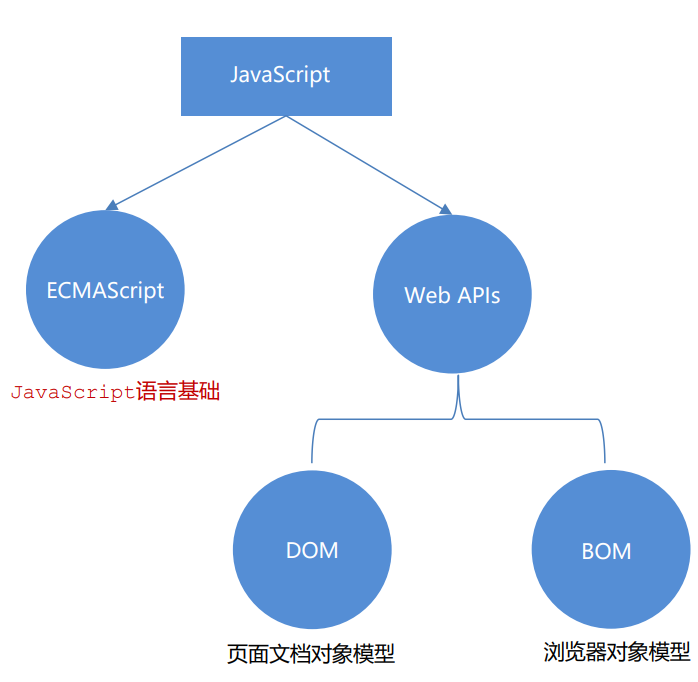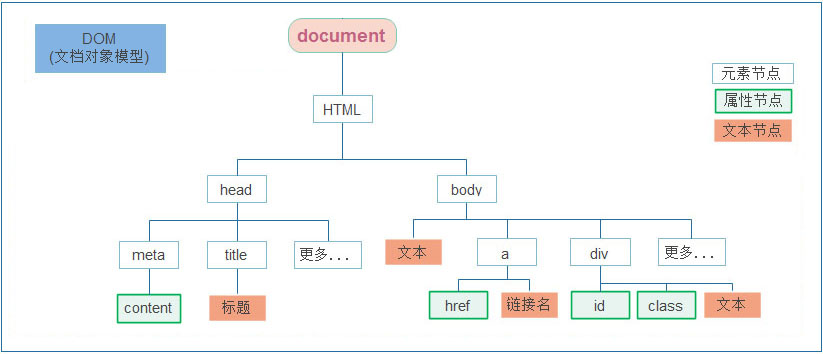Web APIs 认知
作用和分类

- 作用:就是使用JS去操作html和浏览器
- 分类:DOM(文档对象模型)、BOM(浏览器对象模型)
DOM
DOM(Document Object Model - 文档对象模型)是将整个 HTML 文档的每一个标签元素视为一个对象,这个对象下包含了许多的属性和方法,通过操作这些属性或者调用这些方法实现对 HTML 的动态更新,为实现网页特效以及用户交互提供技术支撑。
简单的说:DOM是浏览器提供的一套专门用来操作网页内容的功能
作用:开发网页内容特效和实现用户交互

DOM树
- 将HTML文档以树状结构直观表现出来,称为文档树或DOM树
- 描述网页内容关系的名词
- 作用:直观地体现了标签与标签之间的关系

DOM对象
DOM对象:浏览器根据html标签生成的JS对象
- 所以的标签属性都可以在这个对象上找到
- 修改这个对象的属性会自动映射到标签上
document
document 是 DOM 里提供的一个对象,该对象包含了若干的属性和方法,document 是学习 DOM 的核心。
是用来访问和操作网页内容的
1
2
3
4
5
6
7
8
9
10
11
|
console.log(document.documentElement);
console.log(document.body);
document.write('Hello World!');
|
获取DOM元素
querySelector 满足条件(一个或多个CSS选择器)的第一个元素
querySelectorAll 满足条件(一个或多个CSS选择器)的元素集合,返回伪数组
- 伪数组:有长度和索引号的数组,但是没有
pop()、push()等方法
- 就算只有一个,也是返回一个伪数组
了解其他方式
getElementById:根据id获取一个元素getElementsByTagName:根据标签获取一类元素getElementByClassName:根据类名获取元素
1
2
3
4
5
6
7
8
9
10
11
12
13
14
15
16
17
18
19
20
21
22
| <!DOCTYPE html>
<html lang="en">
<head>
<meta charset="UTF-8">
<meta name="viewport" content="width=device-width, initial-scale=1.0">
<title>DOM - 查找节点</title>
</head>
<body>
<h3>查找元素类型节点</h3>
<p>从整个 DOM 树中查找 DOM 节点是学习 DOM 的第一个步骤。</p>
<ul>
<li>元素</li>
<li>元素</li>
<li>元素</li>
<li>元素</li>
</ul>
<script>
const p = document.querySelector('p')
const lis = document.querySelectorAll('li')
</script>
</body>
</html>
|
总结:
document.getElementById 专门获取元素类型节点,根据标签的 id 属性查找- 任意 DOM 对象都包含
nodeType 属性,用来检检测节点类型
操作元素内容
通过修改 DOM 的文本内容,动态改变网页的内容。
innerText 将文本内容添加/更新到任意标签位置,文本中包含的标签不会被解析。
1
2
3
4
5
6
| <script>
const intro = document.querySelector('.intro')
intro.innerText = '嗨~ 我叫李雷!'
</script>
|
innerHTML 将文本内容添加/更新到任意标签位置,文本中包含的标签会被解析。
1
2
3
4
5
6
| <script>
const intro = document.querySelector('.intro')
intro.innerHTML = '嗨~ 我叫韩梅梅!'
intro.innerHTML = '<h4>嗨~ 我叫韩梅梅!</h4>'
</script>
|
总结:如果文本内容中包含 html 标签时推荐使用 innerHTML,否则建议使用 innerText 属性。
操作元素属性
操作元素常用属性
- 直接能过属性名修改,最简洁的语法
1
2
3
4
5
6
7
8
| <script>
const pic = document.querySelector('.pic')
pic.src = './images/lion.webp'
pic.width = 400;
pic.alt = '图片不见了...'
</script>
|
操作元素样式属性
- 通过修改行内样式
style 属性,实现对样式的动态修改。
通过元素节点获得的 style 属性,本身的数据类型也是对象,如 box.style.color、box.style.width 分别用来获取元素节点 CSS 样式的 color 和 width 的值。
1
2
3
4
5
6
7
8
9
10
11
12
13
14
15
16
17
18
19
20
| <!DOCTYPE html>
<html lang="en">
<head>
<meta charset="UTF-8">
<meta name="viewport" content="width=device-width, initial-scale=1.0">
<title>练习 - 修改样式</title>
</head>
<body>
<div class="box">随便一些文本内容</div>
<script>
const box = document.querySelector('.intro')
box.style.color = 'red'
box.style.width = '300px'
box.style.backgroundColor = 'pink'
</script>
</body>
</html>
|
- 任何标签都有
style 属性,通过 style 属性可以动态更改网页标签的样式,如要遇到 css 属性中包含字符 - 时,使用驼峰命名法,要将 - 去掉并将其后面的字母改成大写,如 background-color 要写成 box.style.backgroundColor
- 操作类名(className) 操作CSS
如果修改的样式比较多,直接通过style属性修改比较繁琐,我们可以通过借助于css类名的形式。
1
2
3
4
5
6
7
8
9
10
11
12
13
14
15
16
17
18
19
20
21
22
| <!DOCTYPE html>
<html lang="en">
<head>
<meta charset="UTF-8">
<meta name="viewport" content="width=device-width, initial-scale=1.0">
<title>练习 - 修改样式</title>
<style>
.pink {
background: pink;
color: hotpink;
}
</style>
</head>
<body>
<div class="box">随便一些文本内容</div>
<script>
const box = document.querySelector('.intro')
box.className = 'pink'
</script>
</body>
</html>
|
注意:
由于class是关键字, 所以使用className去代替
className是使用新值换旧值, 如果需要添加一个类,需要保留之前的类名
通过 classList 操作类控制CSS
为了解决className 容易覆盖以前的类名,我们可以通过classList方式追加、删除和切换类名
1
2
3
4
5
6
7
8
9
10
11
12
13
14
15
16
17
18
19
20
21
22
23
24
25
26
27
28
29
30
31
32
33
34
35
| <!DOCTYPE html>
<html lang="en">
<head>
<meta charset="UTF-8">
<meta http-equiv="X-UA-Compatible" content="IE=edge">
<meta name="viewport" content="width=device-width, initial-scale=1.0">
<title>Document</title>
<style>
div {
width: 200px;
height: 200px;
background-color: pink;
}
.active {
width: 300px;
height: 300px;
background-color: hotpink;
margin-left: 100px;
}
</style>
</head>
<body>
<div class="one"></div>
<script>
let box = document.querySelector('div')
box.classList.add('active')
box.classList.remove('one')
box.classList.toggle('one')
</script>
</body>
</html>
|
操作表单元素属性
表单很多情况,也需要修改属性,比如点击眼睛,可以看到密码,本质是把表单类型转换为文本框
正常的有属性有取值的跟其他的标签属性没有任何区别
获取:DOM对象.属性名
设置:DOM对象.属性名= 新值
1
2
3
4
5
6
7
8
9
10
11
12
13
14
15
16
17
18
19
20
21
22
23
24
25
26
27
28
| <!DOCTYPE html>
<html lang="en">
<head>
<meta charset="UTF-8">
<meta http-equiv="X-UA-Compatible" content="IE=edge">
<meta name="viewport" content="width=device-width, initial-scale=1.0">
<title>Document</title>
</head>
<body>
<input type="text" value="请输入">
<button disabled>按钮</button>
<input type="checkbox" name="" id="" class="agree">
<script>
let input = document.querySelector('input')
input.value = '小米手机'
input.type = 'password'
let btn = document.querySelector('button')
btn.disabled = false
let checkbox = document.querySelector('.agree')
checkbox.checked = false
</script>
</body>
</html>
|
自定义属性
标准属性: 标签天生自带的属性,比如class、id、title等, 可以直接使用点语法操作,比如: disabled、checked、selected
自定义属性:
- 在html5中推出来了专门的data-自定义属性
- 在标签上一律以
data-开头
- 在DOM对象上一律以
dataset对象方式获取
1
2
3
4
5
6
7
8
9
10
11
12
13
14
15
16
17
18
19
| <!DOCTYPE html>
<html lang="en">
<head>
<meta charset="UTF-8">
<meta http-equiv="X-UA-Compatible" content="IE=edge">
<meta name="viewport" content="width=device-width, initial-scale=1.0">
<title>Document</title>
</head>
<body>
<div data-id="1" data-name="自定义"> 自定义属性 </div>
<script>
let div = document.querySelector('div')
console.log(div.dataset.id)
console.log(div.dataset.name)
</script>
</body>
</html>
|
定时器-间歇函数
定时器函数可以开启和关闭定时器
setInterval(函数, 间隔时间)
- 作用:每隔一段时间调用一次这个函数
- 间隔时间单位是毫秒ms
- 打开定时器
1
2
3
4
5
6
7
8
| <script>
function repeat() {
console.log('不知疲倦的执行下去....')
}
setInterval(repeat, 1000)
</script>
|
- 关闭定时器
1
2
3
4
5
6
|
let timer = setInterval(function() {
console.log('执行下去!')
}, 1000)
clearInterval(timer)
|



